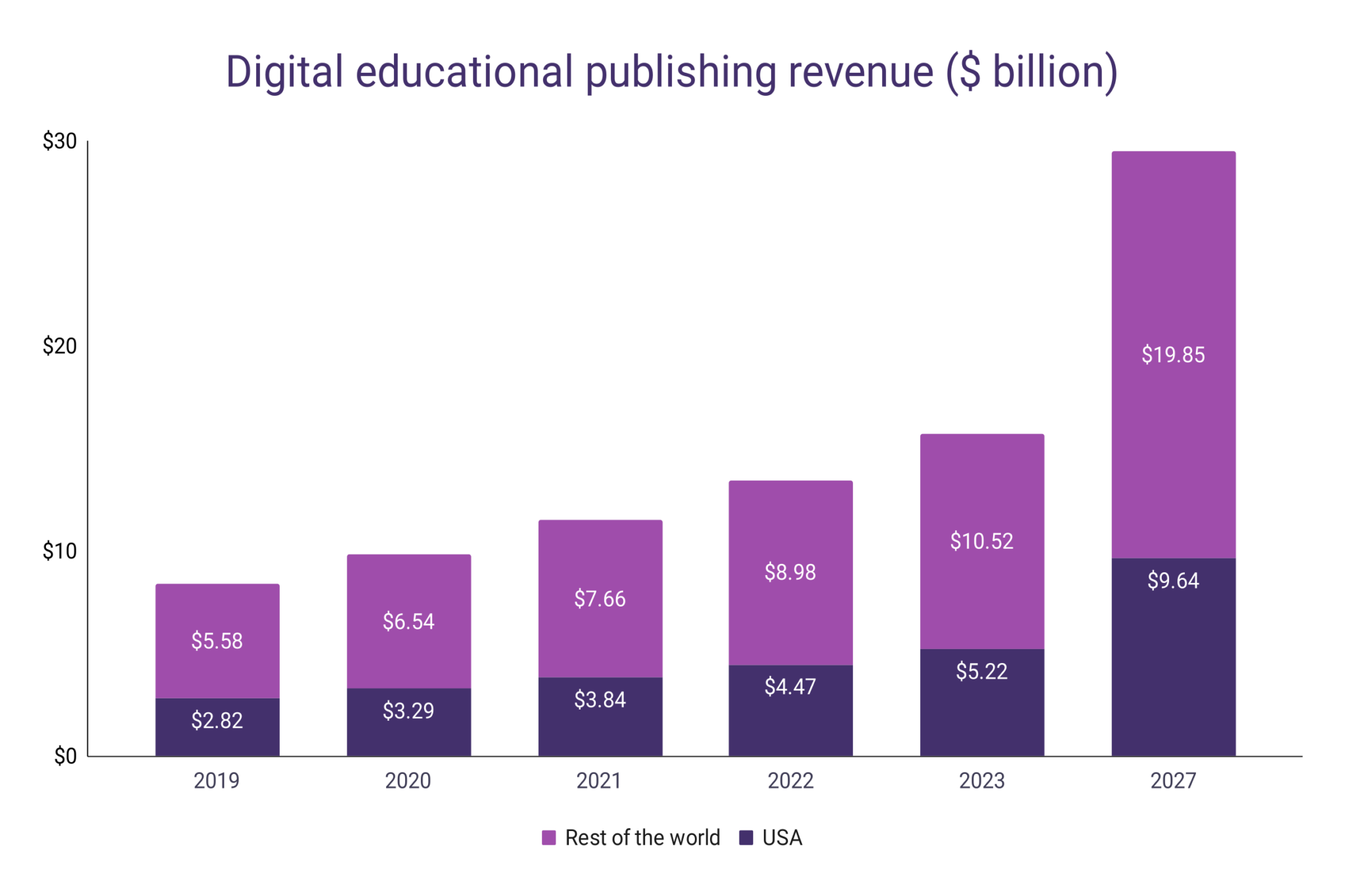The state of digital textbooks around the world in 2023

Where are we with digital textbooks?
Digital textbooks have become an integral part of education worldwide in recent years. With technological advancements, digital textbooks have revolutionized how students learn, study, and interact with course material. This post will explore the current state of digital textbooks around the world in 2023, including their adoption in public education, as well as the role of textbook publishers in the digital textbook market.
Digital textbooks in the US public education
The adoption of digital textbooks in public education in the United States has been slower compared to other countries. While many schools have implemented digital textbooks to some extent, most have not fully converted to digital ones.
In Texas, a bill was passed in 2009 that allocated funds to school districts and charter schools to buy technology required for e-textbooks. The bill granted these schools the flexibility to switch to e-textbooks instead of traditional textbooks. Houston Independent School District (HISD), for example, introduced digital textbooks in 2014 and plans to expand their usage further.
The United States Department of Education has encouraged the adoption of digital textbooks in public education to provide students with more equitable access to educational resources. For instance, in 2015, the Department of Education launched the #GoOpen campaign to promote the use of openly licensed educational resources, including digital resuorces.

Advances in digital textbooks around the world
Several countries around the world have adopted policies to promote the use of digital textbooks in public education.
- India: In 2015, the Indian government launched the "ePathshala" initiative, which aims to provide students with free digital textbooks and educational resources. The ePathshala platform provides access to a wide range of digital textbooks, audio and video resources, and supplementary learning materials across various subject areas and grade levels. In addition to the ePathshala platform, the government has also launched other initiatives to promote digital education, including the National Programme on Technology Enhanced Learning (NPTEL) and the SWAYAM platform, which provides access to online courses and resources from various universities and institutions across India.
- Australia: The Australian government has launched several initiatives to support the digital education revolution, including the $2.4 billion Digital Education Revolution (DER) program, which aimed to provide every secondary school students with access to computers by 2011. The program has since evolved into the Digital Education Revolution – National Partnership (DERNP), which focuses on improving students' digital literacy skills and integrating digital technologies into classrooms. The National Digital Learning Resources Network (NDLRN) provides teachers and students with access to high-quality digital educational resources, including digital textbooks, videos, and interactive learning activities. The network also allows teachers to share educational resources with each other. Moreover, the government has also implemented policies to ensure teachers have the necessary digital skills to effectively integrate digital technologies into their teaching practices such as the Australian Professional Standards for Teachers, which set out the skills and knowledge teachers need to effectively use digital technologies in the classroom.
- Japan: In Japan, the government has launched several initiatives to promote digital textbooks in public education, including the "Digital Textbook Promotion Plan." The Digital Textbook Promotion Plan was launched in 2011 with the goal of equipping all students with digital textbooks by 2015. As of 2023, the effort is still on-going, with the transition being tested on a subject by subject basis starting with English in 2024 and math in 2025. The initiative aims to provide students access to high-quality, interactive digital textbooks that can be updated easily and quickly. The plan also aims to reduce the financial burden on families by providing free or low-cost digital textbooks.
- Sweden: The Swedish government introduced digital education into schools under the National Digitalisation Strategy since 2017. The law is supported by state grants that help schools integrate digital technology into their teaching practices. Tools such as mini-robots and iPads are being used to teach children how to operate "digital machines" and issue commands as early as preschool. The aim of the preschool curriculum is to enhance children's skills to develop a critical and responsible relationship with digital technology, which sets up an environment to promote innovation and to train professionals in the digital sector.
- South Korea: In South Korea, the adoption of digital textbooks has been a priority for the government in recent years. In 2011, the South Korean government launched the "Smart Education" initiative, which aimed to digitalize educational contents by 2015. The current goal is to have all public schools in South Korea fully transitioned to digital textbooks by 2025. To achieve this goal, the ministry has partnered with major Korean tech companies to develop and distribute digital textbooks. The digital textbooks are designed to be interactive and engaging, with features such as multimedia content, interactive quizzes, and personalized learning experiences. The adoption of digital textbooks in South Korea has been well-received by students, teachers, and parents.

Textbook publishers and digital textbooks
Textbook publishers have also started to embrace digital textbooks to reach a wider audience and reduce costs associated with printing and distribution. Many textbook publishers have created digital versions of their textbooks; some have even launched digital-first imprints. For example, Pearson Education, one of the largest textbook publishers in the world, launched Pearson Digital First in 2019, which publishes textbooks exclusively in digital format.

Market size and revenue
The market for digital textbooks has been growing steadily over the years. According to a report by Technavio, the global digital textbook market size was valued at $3.6 billion in 2020 and is expected to reach $7.5 billion by 2025, growing at a CAGR of over 10%. The report also notes that the shift towards digital learning has accelerated due to the COVID-19 pandemic, further driving the growth of the digital textbook market.
While textbook publishers have not revealed specific revenues from their digital textbook sales, it is clear that they are investing in this market as a way to stay relevant and adapt to changing trends in education. According to a research, digital textbook revenue on a global level was at $5.3 billion in 2022 and projected to reach $6.18 billion in 2023. According to the same research, digital textbooks are the biggest contributor to the digital educational publishing industry, accounting for 39.4% of the sales revenue and by 2027, digital textbooks are projected to generate over $11.38 billion in sales revenue on a global level.

Resistance to digital textbooks
Despite the benefits of digital textbooks, there has been some resistance to widespread adoption.
- Screen Time: Some parents and educators worry that increased screen time associated with digital textbooks may negatively impact children's health and well-being.
- Access and Equity: There are concerns that not all students have equal access to digital textbooks and the technology needed to use them, which could exacerbate existing achievement gaps.
- Technological Issues: Technical glitches or malfunctions could disrupt or hinder learning, and not all educators may have the technological expertise to effectively troubleshoot issues.
- Cost: While digital textbooks may have lower upfront costs compared to traditional textbooks, ongoing technology upgrades and licensing fees could add up over time.
- Distractions: The internet connectivity and multimedia features of digital textbooks could lead to distractions and reduced focus on learning.
What's next for digital textbooks?

In conclusion, digital textbooks have become an increasingly popular educational resource, with widespread adoption in schools worldwide. Textbook publishers have also recognized the value of digital textbooks and are investing in this market to stay relevant and adapt to changing trends in education. While there is some resistance to adopting digital textbooks, the future looks promising as more schools and publishers embrace this technology. The market for digital textbooks is expected to continue to grow, further driving innovation in the education industry.
About Pagecall
Pagecall is a state-of-the-art tool for real-time audio, video, and whiteboard interactions facilitating interactive and seamless online communication. We’re transforming the tutoring industry, one lesson at a time.


